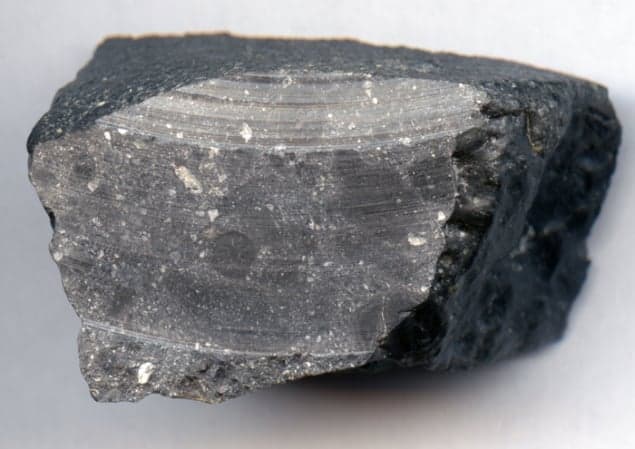
A meteorite recently retrieved from the Sahara Desert bears the oldest known minerals ever seen from the planet Mars, say scientists in the US, Australia and France. These minerals are 4.4 billion years old and therefore formed just 150 million years after the red planet’s birth. Their age confirms earlier indications that the Martian crust formed quickly, as did the crusts of the Earth and Moon.
Today, Mars is a cold, dry, nearly airless desert, but ancient Mars was warmer and wetter, and may even have given rise to life. The planet had a thicker atmosphere then and dried-up riverbeds – signs of a milder climate – course through parts of the planet’s oldest terrain, highlands that blanket most of the southern hemisphere. Scientists know that the highlands are ancient because these regions bear the most craters.
Although NASA has tried to land eight spacecraft on Mars – and succeeded seven times – these landers were not able to measure the ages of rocks nor determine all the chemical elements that constitute them. Scientists therefore value Martian meteorites that they can scrutinize in the laboratory – rocks with isotopic compositions that reveal they came from Mars. Unfortunately, with only one previous exception, all the other Martian meteorites are so young that they originated long after the climate deteriorated.
First-ever rock from the highlands
“It is very exciting that we have the first-ever sample to come from the Martian highlands,” says Munir Humayun, a geochemist at Florida State University in Tallahassee. He and his colleagues studied a Martian meteorite named NWA 7533. It was one of five stones that landed together in northwest Africa, which is what NWA stands for.
The meteorite is a so-called breccia, a collage of different rock fragments. Breccias can form after an asteroid hits a planet and throws up chunks of rock that later conglomerate. These impact breccias litter the cratered highlands of the Moon and presumably Mars. But breccias can also arise after violent volcanic eruptions.
Which type of breccia is NWA 7533 – impact or volcanic? “When we got this meteorite, we looked inside the breccia for clues as to impact,” Humayun says. The search focused on siderophiles, which are “iron-loving” elements. These are rare in a planet’s crust because they sink with iron into the core but are common in asteroids. Sure enough, the meteorite abounded with siderophiles such as nickel and iridium, indicating it was an impact breccia – and therefore probably came from the heavily cratered highlands. “So we thought, ‘Wow! This looks like a highland breccia’,” Humayun says. If so, it had to be old.
Zircons remember
But science is rarely that simple, and this interpretation conflicted with a report earlier this year by other researchers who found that another Martian stone – which fell with NWA 7533 – was too young to have come from the ancient cratered highlands. Fortunately, NWA 7533 contains tough minerals called zircons. “From a geochronological point of view, zircons are like elephants: they remember,” says Humayun. “They are resistant to almost anything.” Even impacts do not destroy them. Moreover, zircon crystals trap uranium, which decays into lead, allowing scientists to date them. With one exception, every zircon in the meteorite had the same age – 4.4 billion years. Humayun’s reaction? “Like, eureka!”
“This is a really exciting find,” says Harry McSween of the University of Tennessee at Knoxville, a planetary scientist unaffiliated with the research team. “It is a much more representative sample of the ancient crust of Mars than we have seen before [among meteorites],” he says. “The zircon method is the best method there is for defining the age of crystallization of a magma, so I’m real confident in this 4.4-billion-year age.”
Only one other Martian meteorite is ancient. In 1996 scientists claimed that a meteorite named ALH 84001 harboured fossils of Martian life. The meteorite was then thought to be 4.5 billion years old, but like the fossils themselves, that figure has not held up to further scrutiny. Later work lowered the age to 4.1 billion years. Therefore, the 4.4-billion-year-old zircons in the new meteorite are the oldest known minerals from Mars.
Fast-forming crust
As the meteorite is a breccia, the zircons came from different rocks throughout the Martian crust, yet all but one have the same old age. That means the crust formed fast, says Humayun. Otherwise, the zircons would have a spread of ages. In addition, the zircons are as old as the earliest zircons on the Earth and Moon, so all three worlds created their crusts at the same time.
Although the new meteorite’s zircons are ancient, the rock itself may be younger. The scientists do not know when the various fragments cemented together to assemble the breccia.
The meteorite contains soil with a composition that nearly matches what NASA’s Spirit rover saw at Gusev Crater. Unlike modern Martian soil, however, the meteoritic soil lacks much sulphur or chlorine – probably because flowing water on a warmer, wetter world carried these elements away.
The scientists publish their work today in Nature.



